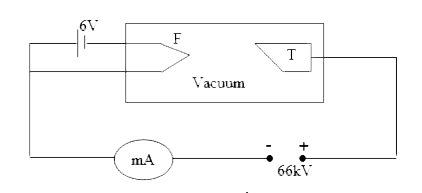Is it possible that in a Coolidge tube characterstic Lα X-rays are emitted but not Kα X-rays?
To determine whether it is possible for characteristic Lα X-rays to be emitted in a Coolidge tube while Kα X-rays are not emitted, we can analyze the processes involved in the emission of these X-rays.
1. Understanding X-ray Emission:
- X-rays are emitted when electrons transition between different energy levels (or shells) of an atom. The two types of characteristic X-rays we are considering are Kα and Lα.
2. K_alpha X-rays:
- Kα X-rays are produced when an electron transitions from the L shell (n=2) to the K shell (n=1). This transition occurs when an electron from the L shell fills a vacancy created in the K shell.
3. L_alpha X-rays:
- Lα X-rays are emitted when an electron transitions from the M shell (n=3) to the L shell (n=2). This transition occurs when an electron from the M shell fills a vacancy created in the L shell.
4. Conditions for Emission:
- For Kα X-rays to be emitted, there must be a vacancy in the K shell, which can occur if an inner-shell electron is ejected (for example, by high-energy collisions with incoming electrons).
- For Lα X-rays to be emitted, there must be a vacancy in the L shell, which can occur if an electron from the K shell is ejected.
5. Possibility of Emission:
- If Lα X-rays are emitted, it implies that there is a vacancy in the L shell. For this vacancy to be created, there must be a prior ejection of an electron from the K shell, which means that Kα X-rays must also be emitted.
- Therefore, if Lα X-rays are present, Kα X-rays must also be emitted as a consequence of the same process.
Conclusion:
It is not possible for characteristic Lα X-rays to be emitted without the emission of Kα X-rays in a Coolidge tube.
- X-rays are emitted when electrons transition between different energy levels (or shells) of an atom. The two types of characteristic X-rays we are considering are Kα and Lα.
- Kα X-rays are produced when an electron transitions from the L shell (n=2) to the K shell (n=1). This transition occurs when an electron from the L shell fills a vacancy created in the K shell.
- Lα X-rays are emitted when an electron transitions from the M shell (n=3) to the L shell (n=2). This transition occurs when an electron from the M shell fills a vacancy created in the L shell.
- For Kα X-rays to be emitted, there must be a vacancy in the K shell, which can occur if an inner-shell electron is ejected (for example, by high-energy collisions with incoming electrons).
- For Lα X-rays to be emitted, there must be a vacancy in the L shell, which can occur if an electron from the K shell is ejected.
- If Lα X-rays are emitted, it implies that there is a vacancy in the L shell. For this vacancy to be created, there must be a prior ejection of an electron from the K shell, which means that Kα X-rays must also be emitted.
- Therefore, if Lα X-rays are present, Kα X-rays must also be emitted as a consequence of the same process.
It is not possible for characteristic Lα X-rays to be emitted without the emission of Kα X-rays in a Coolidge tube.
Topper's Solved these Questions
Similar Questions
X-rays are emitted during
View SolutionAlpha rays are
View SolutionThe characterstics X-ray spectrum is emitted due to transition of
View SolutionAssertion By increasing the accelerationg voltage in coolidge tube wavelength of characteristic X-rays does not change.
Reason Cut-off wavelength is inversely proportional to the acceleration voltage
View SolutionUse Moseley's law with b=1 to find the frequency of the Kα X-rays of La (Z=57) , if the frequency of the Kα X-rays of Cu (Z=29) is know to be 1.88×1018Hz.
View SolutionUse Moseley's law with b = 1 to find the frequency of the Kα X-ray of La(Z=57) if the frequency of the Kα X-ray of Cu(Z=29) is known to be 1⋅88×1018 Hz.
View SolutionUse Moseley's law with b = 1 to find the frequency of the Kα X-ray of La(Z=57) if the frequency of the Kα X-ray of Cu(Z=29) is known to be 1⋅88×1018 Hz.
View Solution
Figure shows intensity versus wavelength graph of X-rays coming from coolidge-tube with molybdenum as target element :
The two peaks shown in graph correspond to Kα and Kβ X-rays
Wavelength of Lα X-rays from Coolidge tube will be (approximately)
View SolutionFigure below shows a simple diagram of a modern X ray tube. (i.e. Coolidge tube).

(i) Find the minimum wavelength of the X rays emitted by the X ray tube.
(ii) What will be the effect of replacing the 6V battery with a 9V battery on the emitted X rays?
View SolutionThe shorted wavelength of X- rays emitted from an X- rays tube depends on
View Solution
